How To Keep Water from Freezing in Chicken Coop
- January 12, 2024
- 10 comment
Despite their small size, chickens require about a pint of fresh water daily to prevent dehydration. One of the primary challenges faced by those keeping chickens in winter is ensuring that the flock’s water remains unfrozen in the face of dropping temperatures. This task becomes particularly daunting for chicken keepers in northern regions, where extreme weather and significant temperature fluctuations are common during the winter months.
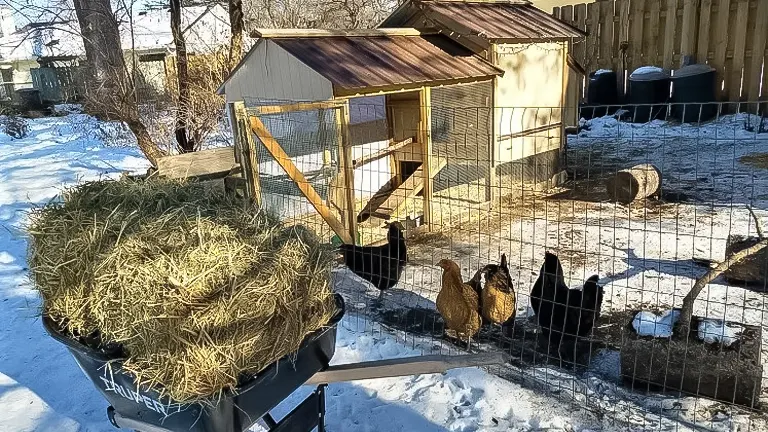
Whether you reside in an area with relatively mild winters or contend with the harshness of extreme winter conditions, having a variety of methods to prevent your flock’s water from freezing is essential. Such strategies not only save time but also contribute to maintaining the health and hydration of your chickens.
While not every approach may be suitable for extremely cold weather, most of them prove effective in preventing water from freezing, even when temperatures hover around the freezing point. With these six methods at your disposal, you’ll have a range of options to keep your flock’s water unfrozen, ensuring their well-being regardless of the winter weather conditions.
List on How To Keep Water from Freezing in Chicken Coop:
- Poultry Water Heaters
- Containers of a Black Hue for Water
- Saltwater Bottle Method
- Warm Water and Water Containers
- Mini Greenhouse Solution
- Maintain Fluidity
Evaluate Six Options for Heating Chicken Water
When considering the task of evaluating six options for heating chicken water, it’s crucial to recognize the diverse needs of different coops and flocks. The choice of a suitable method to prevent the freezing of your chickens’ water should be contingent upon various factors, including the specific climate of your region, unique characteristics of your coop, and other pertinent considerations.
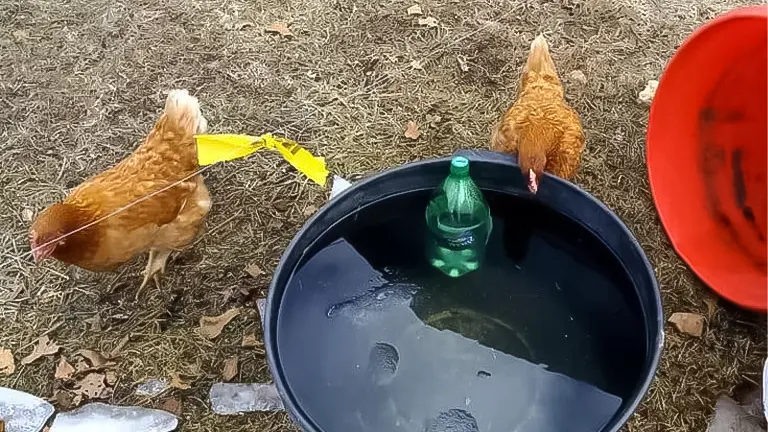
Each heating option may vary in effectiveness depending on these factors, making it essential to carefully compare and select the most appropriate solution tailored to your specific circumstances. By taking into account these individualized factors, you can ensure that the chosen heating method is not only efficient in preventing water freezing but also aligns seamlessly with the unique requirements of your coop and flock, ultimately promoting the health and well-being of your chickens.
1. Poultry Water Heaters

Maintaining a frost-free water supply for your poultry is crucial, and employing a poultry water heating system is a dependable solution, albeit one that necessitates access to electricity. If your chicken coop lacks electrical infrastructure, you may need to install power cables, adding an extra layer of effort to the convenience of having electricity in the coop.
Heated Water Bases
An alternative approach involves utilizing heated water bases designed specifically for poultry. Numerous companies offer these bases, which can be positioned within the coop with a bell water system placed atop. Activating when temperatures dip below a set threshold, the heated base prevents water from freezing. It’s essential to note that most of these bases require electricity. To avoid rusting, it is advisable to use plastic water systems on these heated bases, as opposed to galvanized or metal counterparts.
DIY Heated Water Base
For a cost-effective alternative to purchasing a poultry water heater, you can craft your own heated water base. This involves utilizing a 25-40 watt lightbulb enclosed in a secure container, such as a tin container or hollow cement block, on which a water system can be placed in the coop or enclosure. By turning on the light bulb, you generate sufficient heat to prevent water freezing. It is imperative, however, to ensure all electrical connections are made safely and correctly when constructing your DIY heated water base.
Heated Pet Water Bowl
Consider incorporating heated pet bowls into your strategy for preventing frozen water. While effective in keeping water unfrozen, these bowls may lead to dirtier water due to increased surface exposure. Elevating the heated pet bowl on blocks to the height of your shortest bird’s back can mitigate contamination by preventing dirt and debris from easily entering the water.
Electric Water Heater System Precautions
When opting for a water heating system requiring electricity, exercise caution to ensure all electrical connections are securely and properly established. Avoid using extension cords in the chicken coop and keep all electrical components out of the flock’s reach. Be vigilant about potential hazards such as cords that chickens could trip over, fly into, or pull out. If you reside in an area with harsh, cold winters, the reliability of heated water systems in below-freezing temperatures might justify the investment.
2. Containers of a Black Hue for Water

While electrically powered heating systems are considered the most dependable means to prevent your flock’s water from freezing, there are alternative off-the-grid methods that can be effective in regions where winter temperatures are less severe. These off-the-grid options offer a viable solution without the need to extend electricity to your chicken coop, particularly in areas with milder winter conditions.
One such off-the-grid approach harnesses the sun’s heat to maintain your flock’s water at a non-freezing temperature. Objects with a black surface efficiently absorb solar heat and retain it, providing sustained warmth even in cold weather. Placing your flock’s water either in or on top of a black object capitalizes on this principle, utilizing the absorbed heat to prevent freezing. Here are several practical ideas for implementing this off-the-grid solution in your flock’s water system:
- Old Tires:
- Usage: Place waterers inside or on an old tire.
- Explanation: Old tires, with their black rubber composition, act as effective heat absorbers. By situating your waterers within or on top of these tires, they benefit from the heat absorbed by the black surface, preventing the water from freezing. The tire provides insulation and retains warmth, making it a practical and sustainable solution.
- Rubber Livestock Tubs:
- Usage: Utilize small rubber livestock bowls or tubs as your flock’s water source.
- Explanation: Similar to old tires, rubber livestock tubs are excellent heat absorbers. These tubs can be used as water containers, benefiting from the heat absorption properties of the material. The compact size makes them suitable for smaller flocks, and their insulation helps keep the water from freezing in milder winter conditions.
- Black Plastic:
- Usage: Wrap black plastic around a block of wood or another flat object, using it as a stand for your water system.
- Explanation: Black plastic, when wrapped around a block of wood or a flat surface, creates a makeshift stand with heat-absorbing capabilities. This stand can be used to elevate water containers, ensuring that they are exposed to the sun’s rays. The absorbed heat from the black plastic helps maintain the water temperature above freezing, providing an economical and simple solution for off-the-grid water heating.
These methods showcase resourcefulness by utilizing common items and materials to harness solar heat, making them suitable alternatives for preventing water freezing without relying on electrical heating systems.
Sunlight Necessity
Regardless of the water heating system you opt for, it’s crucial to ensure that the water setup is exposed to sunlight. This exposure is essential for the black surface to absorb enough heat to effectively prevent the water from freezing. Regular cleaning of the water system is imperative to prevent the accumulation of algae, which could pose a health risk to your flock. Additionally, take precautions to secure the water system to prevent tipping by your flock, ensuring a stable and reliable water source for their well-being. Regular attention to these details will contribute to the success and safety of your off-the-grid water heating solution.
3. Saltwater Bottle Method
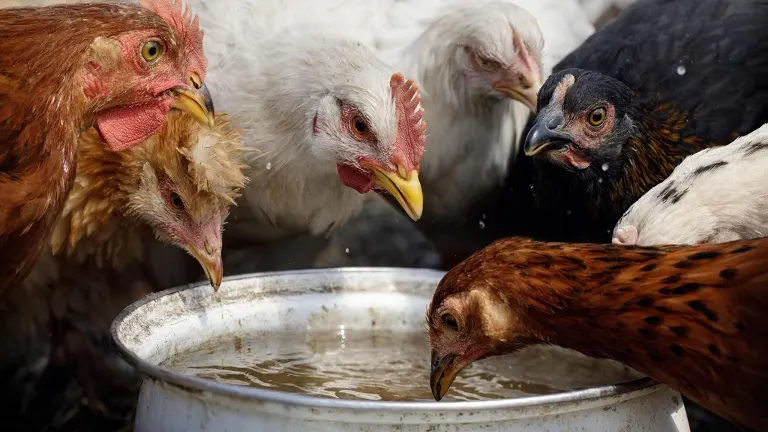
Employing the saltwater bottle trick presents an effective strategy to safeguard your flock’s water from freezing during cold weather, with the critical note that you should never add salt directly to your chickens’ drinking water, as it can be lethal for them.
Instead, create a secure saltwater solution and encase it in a bottle, which is then placed within your flock’s water source. The buoyant, saltwater-filled bottle dynamically prevents freezing by leveraging the natural property of salt to lower the freezing point of water.
DIY Saltwater Bottle System for Chickens
To concoct the saltwater solution, bring approximately 3 cups of water to a boil. Once boiling, remove the water from the heat source and add 1/3 cup of salt, stirring until the salt is completely dissolved. If pouring the mixture into a plastic bottle, allow it to cool slightly before proceeding.
Carefully pour the saltwater solution into a bottle suitable for your flock’s water source, ensuring a tight and leak-proof seal on the lid. Subsequently, position the bottle in your flock’s water, effectively deploying the saltwater solution to prevent freezing.
Double-Check Protocol
Regular monitoring of your flock’s water during freezing weather remains essential. If the saltwater bottle begins to freeze, there is a risk of cracking and contaminating the flock’s water. It’s worth noting that the saltier the saltwater solution, the slower it freezes. A water mixture saturated with salt, containing as much salt as it can hold, will freeze at a significantly lower temperature of -6°F, providing additional resilience against rapid freezing.
4. Warm Water and Water Containers
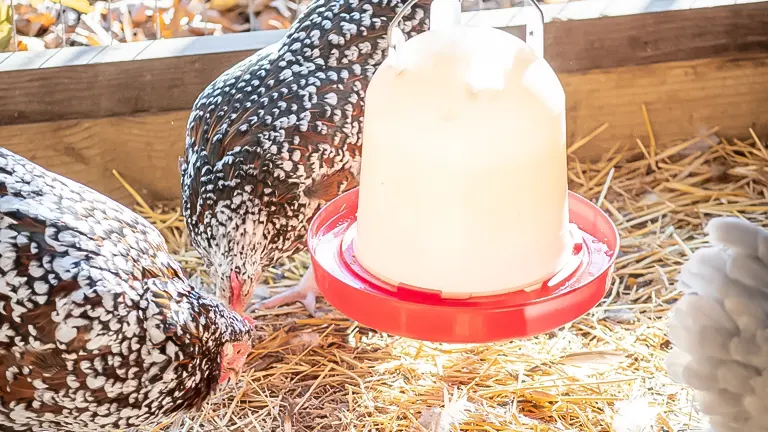
Ensuring your flock has access to warm water within an already heated water system can effectively prevent freezing when faced with brief or moderately cold temperatures. The temperature of the water directly correlates with its freezing time, and warmer water tends to resist freezing for a more extended period.
Striking a Balance
However, there’s a crucial consideration with this approach chickens are reluctant to drink excessively warm water. To prevent dehydration, it’s essential to maintain water palatability. Optimal results are achieved by providing water at room temperature or slightly lukewarm conditions, ensuring your flock stays adequately hydrated during cold weather.
Warming the Water System
Enhance the efficiency of this method by utilizing a water system that has been pre-warmed, allowing it to retain heat and extending the period before freezing occurs. A practical way to warm your flock’s water system is by cleaning it with hot water. This proves especially effective in situations where temperatures are cold in the morning but warm up later in the day.
Simply provide the warmed water in the morning, and it should remain unfrozen until outside temperatures rise. If cold conditions persist throughout the day, periodic refilling and rewarming of the water system may be necessary, or exploring alternative methods to prevent freezing becomes essential. This detailed approach ensures your flock has consistent access to unfrozen water while maintaining their comfort and hydration during cold weather.
5. Mini Greenhouse Solution
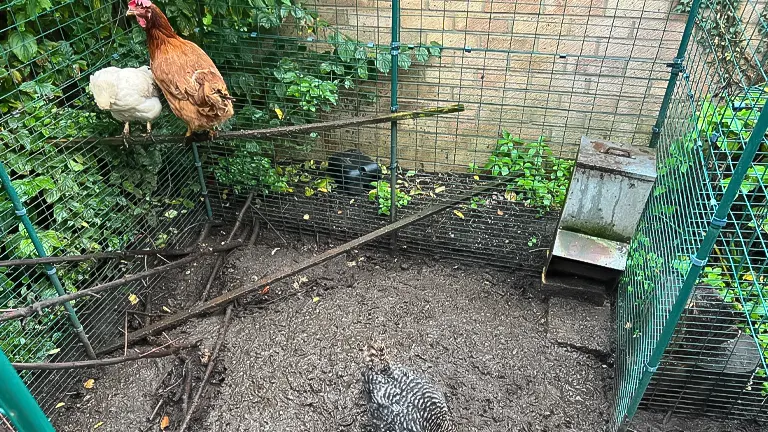
An alternative method involves constructing a mini greenhouse, designed to harness the sun’s energy and warmth. Much like how black surfaces absorb heat, greenhouses operate by trapping and retaining heat to create a warmer environment.
Constructing a Mini-Greenhouse for Your Chickens’ Water
Crafting a mini greenhouse offers flexibility in material choice, including repurposing old windows or employing clear, heavy-duty plastic. Joining two old windows can form a tent-like structure under which the water system can be placed. Alternatively, constructing a wooden frame and securing clear plastic to it creates a protective greenhouse shelter for your flock’s water system.
Infuse Sunshine
Optimal placement of the mini greenhouse is in a sunny location to maximize heat absorption from the sun. The combined effect of the greenhouse trapping heat and reducing the impact of wind-chill can help maintain your flock’s water in a liquid state even during below-freezing temperatures.
Maintenance Consideration
It’s essential to note that the mini greenhouse approach requires daily cleaning of your flock’s water system. The increased warmth and exposure to sunlight create conditions conducive to algae growth. By addressing this maintenance aspect, you ensure a consistently effective and hygienic solution for keeping your flock’s water unfrozen in colder climates.
6. Maintain Fluidity
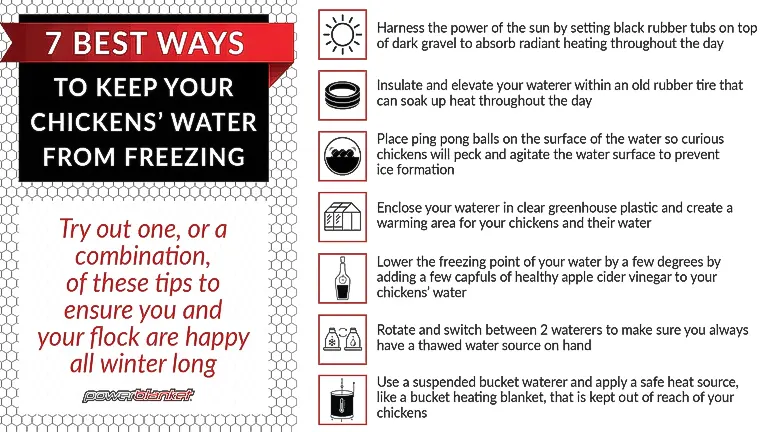
Finally, another technique to prevent your flock’s water from freezing in cold temperatures involves ensuring constant movement in the water. Moving water has a slower freezing rate compared to stagnant water.
There are multiple methods to induce movement in your flock’s water source:
- Golf balls – or any buoyant object that can float and bob in the water to create movement.
- Fountain – It’s creation establishing a mini fountain as the water source for your flock.
- Aerator – are utilization to introduce bubbles and promote water movement.
- Utilization – kind of a fish tank filter without the actual filtering component, solely for maintaining water circulation.
The speed of water movement directly correlates with the time it takes for freezing to occur. While some of these systems may require electricity, alternative options can be easily implemented without the need for a power source. It’s imperative to prioritize the safety and health of your flock, avoiding water movement systems that could potentially contaminate their water supply. Always exercise caution and choose methods that ensure the well-being of your chickens.
Ensuring Well Hydrated and Healthy Chickens in Winter
Maintaining the hydration of your chickens is paramount for their overall health, regardless of the severity of winter weather. The following six strategies offer a diverse range of options to prevent your flock’s water from freezing. Whether you opt for off-the-grid solutions harnessing natural elements or leverage electric water heating systems, there are ideas suitable for various coop setups. By prioritizing fresh water and providing a well-balanced and nutritious diet, you can keep your flock hydrated and healthy throughout the winter season, promoting their well-being in different weather conditions.
Final Conclusion
In conclusion, maintaining a constant and unfrozen water supply for your chickens during winter is essential for their well-being. From off-the-grid approaches like utilizing black surfaces, mini greenhouses, or saltwater bottles to electric solutions such as heated water bases or warm water systems, a variety of methods cater to different coop setups and preferences. It’s crucial to strike a balance between warmth and palatability, ensuring chickens receive water that is not too warm but still enticing for consumption. Consistent monitoring, daily cleaning, and strategic placement of water systems contribute to the success of these techniques. Prioritizing the health and hydration of your flock by employing these diverse strategies guarantees a thriving and contented chicken coop even in the coldest of winters.
Frequently Asked Questions
- Can I use regular table salt to create a saltwater bottle for preventing water freezing in my chicken coop?
While table salt can be used, it’s advisable to use non-iodized salt to avoid potential harm to your chickens. Follow recommended proportions for a safe and effective saltwater solution. - Are heated water bases safe for use with plastic water containers, or should I opt for metal alternatives?
Heated water bases work well with plastic water systems, but it’s crucial to avoid metal containers to prevent rusting. Plastic is a better insulator and ensures the longevity of the system. - Can I build a mini greenhouse using materials other than old windows or clear plastic?
Absolutely! You can construct a mini greenhouse using various materials, including wood frames and clear plastic sheeting or recycled materials that allow sunlight penetration. - How often should I clean the water system when using a mini greenhouse to prevent freezing?
Cleaning the water system daily is recommended to mitigate algae growth due to increased warmth and sunlight exposure within the greenhouse. - Is it safe to use a fish tank filter without the filtering component to keep water circulating in freezing temperatures?
Yes, it’s safe to use a fish tank filter without the actual filter for water circulation, but ensure the system is secure and won’t harm your chickens. Regular checks are essential. - What is the freezing point of saturated saltwater, and how can I ensure it won’t harm my chickens?
Saturated saltwater freezes at approximately -6°F. To prevent harm, follow recommended proportions when creating a saltwater bottle and monitor the water for freezing to avoid potential risks. - Can I use a regular water heater for my chicken coop’s water supply during winter?
It’s possible, but ensure the water heater is designed for poultry use and has safety features to prevent accidents. Follow manufacturer guidelines and place the heater securely. - Are there alternative off-the-grid methods for preventing water freezing without using electricity
Certainly! Options include black surfaces, mini greenhouses, and keeping water moving using simple techniques like floating objects, fountains, aerators, or filters without actual filtering. - Can I combine different methods, such as using a mini greenhouse and a saltwater bottle, for added effectiveness?
Yes, combining methods can enhance effectiveness. Ensure compatibility and monitor the conditions to adjust as needed for optimal results. - How can I ensure my chickens are not dehydrated while using warm water systems in the coop?
Strive for a balance by providing room temperature or slightly lukewarm water. Monitor chicken behavior to ensure they are drinking adequately and adjust water temperature accordingly.
We’re eager to learn from your experiences! Feel free to share your tips, tricks, and personal insights on keeping water unfrozen in the chicken coop in the comments below. Your valuable input may offer fellow chicken keepers valuable guidance in navigating the challenges of winter water management!

Edward Smith
Forestry AuthorWoodworking is about more than crafting; it's a harmonious connection with nature, mastering tools, and preserving our environment. I'm here to share my knowledge and experiences with you, forging a future where we can embrace wood's beauty and utility while safeguarding our forests' health and diversity.
10 comments
I Have chickens
Reginald Frazier
March 16, 2024 4:47 pmWell written Ed Word Smith!
Steve
January 18, 2024 4:28 pmHow do you keep the salt water bottle in the water bucket or water bowl?
Melinda
January 18, 2024 2:10 pmHi Melinda, When I had to keep a salt water bottle in the water bucket, I tried several methods. I found using a string to secure it worked quite well. I also tried placing it in a holder which was equally effective. It was all about finding what worked best in my situation. So, don’t hesitate to experiment until you find your perfect solution!
Edward Smith
January 19, 2024 7:16 amYou can also wrap a heat tape around your waterwr. I use a 5 gallon bucket with little cups with toggles near the bottom of the bucket. I have used the heated water base but if we get a real cold snap, the water near the top freezes anyway. I have also used a commercial heated waterer but it was plastic and the well cracked after we lost power and it froze.
Farmgirl49242
January 18, 2024 5:37 amGreat idea using heat tape and a 5-gallon bucket! It’s unfortunate about the commercial heated waterer. Your insights could help others. Thanks for sharing!
Edward Smith
January 18, 2024 5:56 amI use an aquarium heater in a 5 gallon bucket with nipples on the side...not vertical. Works flawlessly.
Bill
January 18, 2024 12:20 amI do not yet have my chickens and am using the cold winter months to read and gain knowledge about their needs so I can be ready to care for them in the spring when I finally get my six female Silkies. I have an idea that maybe some of the engineering geniuses may be able to come up with a brilliant solution to my brilliant idea. Could you build something that has a pinwheel on the top and a small propeller on the bottom that sits in the water? We sometimes get winter storms with 40 mph winds. It would turn the pinwheel and churn the water to keep it from freezing. Hope this gives someone a useful idea.
Patricia Bowser
January 20, 2024 7:13 amThat sounds like a fantastic solution! It’s great to hear that the aquarium heater in a 5-gallon bucket is working flawlessly for you. The idea of placing nipples on the side rather than vertically is quite innovative. Thanks for sharing your experience. It could be really helpful for others facing the same challenge. Thank You!

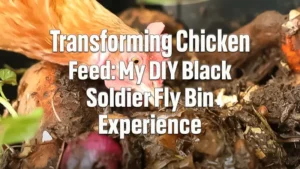











I need to know if I can get a agriculture On my cash purchases
Reginald Frazier
March 16, 2024 4:50 pm